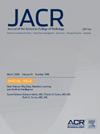ACR Appropriateness Criteria® Suspected and Known Heart Failure: 2024 Update
IF 5.1
3区 医学
Q1 RADIOLOGY, NUCLEAR MEDICINE & MEDICAL IMAGING
引用次数: 0
Abstract
Heart failure (HF) is a prevalent and complex clinical syndrome with no single reference standard diagnostic test. Imaging has a supportive role in patients with suspected and known HF, including initial imaging assessment of an adult with suspected HF, but without history of HF, including evaluation of pulmonary edema and detection of left ventricular dysfunction (Variant 1). In adults with established diagnosis of HF but unknown etiology, imaging also has an important role in the assessment of the underlying disease process, including ischemic and nonischemic etiologies (Variant 2). In the course of continuing care for adult patients with an established diagnosis of HF without new symptoms, follow-up imaging is performed to assess for longitudinal changes in ventricular function, response to therapy and prognostication (Variant 3).
The American College of Radiology Appropriateness Criteria are evidence-based guidelines for specific clinical conditions that are reviewed annually by a multidisciplinary expert panel. The guideline development and revision process support the systematic analysis of the medical literature from peer reviewed journals. Established methodology principles such as Grading of Recommendations Assessment, Development, and Evaluation or GRADE are adapted to evaluate the evidence. The RAND/UCLA Appropriateness Method User Manual provides the methodology to determine the appropriateness of imaging and treatment procedures for specific clinical scenarios. In those instances where peer reviewed literature is lacking or equivocal, experts may be the primary evidentiary source available to formulate a recommendation.
ACR适宜性标准®疑似和已知心力衰竭:2024年更新
心衰(HF)是一种普遍而复杂的临床综合征,没有单一的参考标准诊断测试。影像学对疑似和已知HF患者具有支持作用,包括对疑似HF但无HF病史的成人的初始影像学评估,包括肺水肿的评估和左心室功能障碍的检测(变异1)。在确诊HF但病因不明的成人中,影像学在评估潜在疾病过程中也有重要作用,包括缺血性和非缺血性病因(变异2)。在对确诊为心衰且无新症状的成年患者的持续护理过程中,进行随访成像以评估心室功能的纵向变化、对治疗的反应和预后(变异3)。美国放射学会适当性标准是针对特定临床条件的循证指南,每年由多学科专家小组审查。指南的制定和修订过程支持对同行评议期刊的医学文献进行系统分析。已建立的方法原则,如建议分级评估,发展和评估或GRADE适用于评估证据。兰德/加州大学洛杉矶分校适当方法用户手册提供了确定特定临床情况下成像和治疗程序的适当性的方法。在同行评议文献缺乏或模棱两可的情况下,专家可能是制定建议的主要证据来源。
本文章由计算机程序翻译,如有差异,请以英文原文为准。
求助全文
约1分钟内获得全文
求助全文
来源期刊

Journal of the American College of Radiology
RADIOLOGY, NUCLEAR MEDICINE & MEDICAL IMAGING-
CiteScore
6.30
自引率
8.90%
发文量
312
审稿时长
34 days
期刊介绍:
The official journal of the American College of Radiology, JACR informs its readers of timely, pertinent, and important topics affecting the practice of diagnostic radiologists, interventional radiologists, medical physicists, and radiation oncologists. In so doing, JACR improves their practices and helps optimize their role in the health care system. By providing a forum for informative, well-written articles on health policy, clinical practice, practice management, data science, and education, JACR engages readers in a dialogue that ultimately benefits patient care.
 求助内容:
求助内容: 应助结果提醒方式:
应助结果提醒方式:


